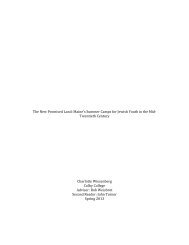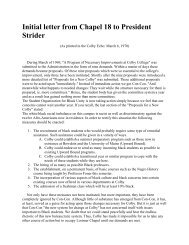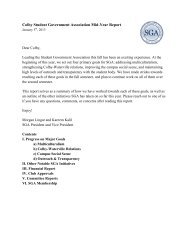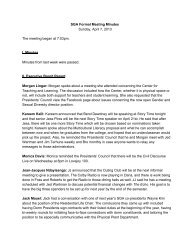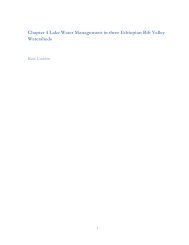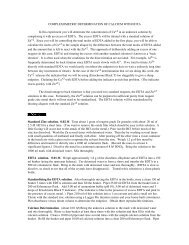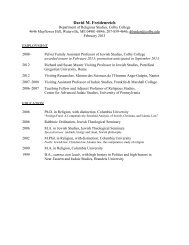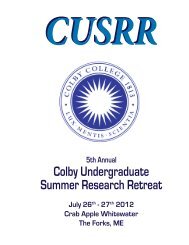Salmon Lake and McGrath Pond Watershed 2009
Salmon Lake and McGrath Pond Watershed 2009
Salmon Lake and McGrath Pond Watershed 2009
Create successful ePaper yourself
Turn your PDF publications into a flip-book with our unique Google optimized e-Paper software.
<strong>Salmon</strong> <strong>Lake</strong> <strong>and</strong> <strong>McGrath</strong> <strong>Pond</strong> <strong>Watershed</strong> Study<br />
Colby Environmental Assessment Team<br />
Executive Summary<br />
December 10, <strong>2009</strong><br />
In the summer <strong>and</strong> fall of <strong>2009</strong>, the Colby Environmental Assessment Team (CEAT) studied<br />
the water quality of <strong>Salmon</strong> <strong>Lake</strong> <strong>and</strong> <strong>McGrath</strong> <strong>Pond</strong>, located in the Belgrade <strong>Lake</strong>s Region of<br />
Maine. The physical, chemical <strong>and</strong> biological characteristics of water quality were measured <strong>and</strong><br />
analyzed to evaluate the current health of these lakes. Water quality data collected during the<br />
summer <strong>and</strong> fall of <strong>2009</strong> were compared with data from previous years to study the historic<br />
water quality trends. L<strong>and</strong> use patterns in the <strong>Salmon</strong>/<strong>McGrath</strong> watershed were also examined to<br />
investigate their impact on the lake water quality.<br />
The water quality trends suggest an improvement in the transparency of <strong>Salmon</strong> <strong>Lake</strong> <strong>and</strong><br />
<strong>McGrath</strong> <strong>Pond</strong> over the last 34 years. Improvements in transparency have been greater for<br />
<strong>McGrath</strong> <strong>Pond</strong> than for <strong>Salmon</strong> <strong>Lake</strong>. In 1975, <strong>McGrath</strong> <strong>Pond</strong> <strong>and</strong> <strong>Salmon</strong> <strong>Lake</strong> had<br />
transparencies of 4 m <strong>and</strong> 5 m, respectively. In <strong>2009</strong>, both water bodies had transparencies of<br />
approximately 5.5 m. Data from <strong>2009</strong> show the productivity of <strong>Salmon</strong> <strong>Lake</strong> to be higher.<br />
Consequently the threat of eutrophication is higher in <strong>Salmon</strong> <strong>Lake</strong> than in <strong>McGrath</strong> <strong>Pond</strong>.<br />
Mean phosphorus levels recorded in this study were 13 ppb for <strong>Salmon</strong> <strong>Lake</strong> <strong>and</strong> 10.6 ppb for<br />
<strong>McGrath</strong> <strong>Pond</strong>. In September of <strong>2009</strong>, phosphorus levels at the deepest part of <strong>Salmon</strong> <strong>Lake</strong><br />
approached 300 ppb compared to less than 10 ppb for <strong>McGrath</strong> <strong>Pond</strong>. Phosphorus from the<br />
bottom can be mixed into the water column during spring <strong>and</strong> fall mixing events. When<br />
phosphorus levels exceed 12-15 ppb, the lake is at risk for algal blooms. The last recorded algae<br />
bloom in <strong>Salmon</strong> <strong>Lake</strong> was in 2002-2003.<br />
The decreasing trends in productivity of <strong>Salmon</strong> <strong>Lake</strong> <strong>and</strong> <strong>McGrath</strong> <strong>Pond</strong> indicate decreasing<br />
levels of phosphorus, but concentrations are still near the 12-15 ppb tipping point, at which algal<br />
blooms may occur. Algal blooms can be detrimental to the health of organisms in the lake, may<br />
decrease the aesthetic value of the lake <strong>and</strong> can reduce the value of shoreline homes. Efforts<br />
should be taken to decrease nutrient levels in the water. <strong>Salmon</strong> <strong>Lake</strong> is much more likely to<br />
develop algal blooms than <strong>McGrath</strong> <strong>Pond</strong> because of higher phosphorus levels.<br />
In late summer <strong>2009</strong>, <strong>Salmon</strong> <strong>Lake</strong> experienced very low dissolved oxygen levels in the<br />
hypolimnion—the bottom layer of lake water. The lack of oxygen on the bottom during the<br />
summer months is due to stratification of the water column, which prevents mixing of oxygen<br />
rich water from the surface. When the lake is stratified <strong>and</strong> mixing is not occurring, existing<br />
oxygen on the bottom of the water column is depleted by populations of decomposers that thrive<br />
because of the availability of organic matter in aging lakes.<br />
Following is a brief summary of findings from the <strong>2009</strong> CEAT study of <strong>Salmon</strong> <strong>Lake</strong> <strong>and</strong><br />
<strong>McGrath</strong> <strong>Pond</strong> <strong>and</strong> their watershed:<br />
<strong>Salmon</strong> <strong>Lake</strong> <strong>and</strong> <strong>McGrath</strong> <strong>Pond</strong> have a combined surface area of 2,043 hectares (ha).<br />
<strong>Salmon</strong> <strong>Lake</strong> has one deep basin, with the deepest point of the two lakes reaching 17.4 m.<br />
The deepest section of <strong>McGrath</strong> <strong>Pond</strong> reaches 7 m.
The recent discovery of Eurasian watermilfoil in Kozy Cove of <strong>Salmon</strong> <strong>Lake</strong> is<br />
particularly troubling for Great <strong>Pond</strong> because water flows from <strong>Salmon</strong> <strong>Lake</strong> to Great<br />
<strong>Pond</strong> by way Kozy Cove <strong>and</strong> Hatchery Brook. Once discovered, the Maine Department<br />
of Environmental Protection took actions to eradicate the presence of Eurasian<br />
watermilfoil in Kozy Cove, on the southeast side of <strong>Salmon</strong> <strong>Lake</strong>. Because the majority<br />
of <strong>Salmon</strong> <strong>Lake</strong> <strong>and</strong> <strong>McGrath</strong> <strong>Pond</strong> is shallow (less than 8 m) <strong>and</strong> invasive macrophytes<br />
such as Eurasian watermilfoil prefer shallow water for colonization <strong>and</strong> establishment,<br />
these lakes are at high risk of invasive species colonization. Continued monitoring <strong>and</strong><br />
vigilance of volunteers, researchers <strong>and</strong> residents is critical for the prevention of further<br />
invasive species establishment.<br />
The mean epicore phosphorus concentration in <strong>Salmon</strong> <strong>Lake</strong> <strong>and</strong> <strong>McGrath</strong> <strong>Pond</strong> was 13.0<br />
ppb <strong>and</strong> 10.6 ppb respectively. The largest external contributors to phosphorus loading<br />
as percentages of the total external load into the water body are shoreline residential<br />
septic systems (14.9%), atmospheric input (13.1%), cropl<strong>and</strong> (11.1%), shoreline<br />
development (10.1%), non-shoreline development (9.1%), logged areas (8.7%) <strong>and</strong> youth<br />
camp septic systems (8.6%).<br />
<strong>Salmon</strong> <strong>Lake</strong> <strong>and</strong> <strong>McGrath</strong> <strong>Pond</strong> have a flushing rate of 0.47 flushes per year, based on<br />
the water budget calculated by CEAT, with 66% of water inputs coming from runoff <strong>and</strong><br />
34% from precipitation.<br />
L<strong>and</strong> use has undergone several changes in the period between 1965/66 <strong>and</strong> 2007:<br />
o Non-shoreline residential area has increased 142.9% <strong>and</strong> now covers 135 ha of<br />
the watershed. Shoreline residences have increased by only 29.5% (54.9 ha),<br />
likely because much of the shoreline was already developed by 1965/66.<br />
o CEAT estimates that there are 19 shoreline lots that could be developed. There<br />
are also other non-shoreline areas where potential development might occur<br />
within the watershed. Limits to development include lack of municipal sewage<br />
<strong>and</strong> water treatment, the topography of the watershed, shoreline zoning<br />
ordinances <strong>and</strong> the current economic downturn.<br />
o Agricultural l<strong>and</strong> decreased 60.1% since 1965/66, which is consistent with trends<br />
in surrounding watersheds <strong>and</strong> throughout central Maine.<br />
o Logged area in the northwestern part of the watershed has increased significantly,<br />
from 3.3% to 8.2%.<br />
o Forested l<strong>and</strong> in the watershed has significantly decreased from 71.5% to 65.1%<br />
(a decrease of 71 ha) due to logging <strong>and</strong> development.<br />
o High impact development, which includes commercial <strong>and</strong> municipal l<strong>and</strong> uses,<br />
increased from 2.23 ha in 1965/66 to 14.2 ha (0.69%) in 2007.<br />
There are 66 camp roads, 3 state roads <strong>and</strong> 12 town roads in the <strong>Salmon</strong>/<strong>McGrath</strong><br />
watershed. Camp roads cover 13.2 miles, <strong>and</strong> state <strong>and</strong> town roads cover 27.7 miles.<br />
Many of the camp roads could have a negative impact on the watershed due to their<br />
proximity to the shoreline. Camp roads are generally privately owned <strong>and</strong> maintained by<br />
residents living on each road. Many camp roads fall into disrepair because residents lack<br />
the funding <strong>and</strong> knowledge of road repair to keep the road well maintained.<br />
Based on the CEAT road survey, over half of the camp roads are in fair (35%) or poor<br />
(23%) condition, <strong>and</strong> are likely contributors of phosphorus into the lake. These roads<br />
will continue to pose problems, if they are not repaired <strong>and</strong> maintained. Likewise, further<br />
degradation of roads currently rated as good (15%) or acceptable (27%) could increase<br />
2
phosphorus loading into the lake. Regular road maintenance can prevent significant<br />
nutrient-loading problems from developing.<br />
Specific problems found during the road survey were recorded <strong>and</strong> suggestions of how to<br />
address these problems are included in the report. Common problems with roads include<br />
presence of tire ruts <strong>and</strong> potholes, missing or damaged culverts <strong>and</strong> ditches <strong>and</strong> loose<br />
surface material, which should be repaired to minimize erosion.<br />
Septic systems installed before 1974 may contribute more phosphorus to the lake than<br />
newer systems because they were not designed to meet the current Maine regulations.<br />
CEAT anticipates that installation of new, more efficient septic systems will accompany<br />
new construction as the population in the watershed increases over the next 20 years.<br />
Soil types throughout the watershed have been rated by the Kennebec County Soil <strong>and</strong><br />
Water Conservation District as very limited for septic suitability, which suggests that<br />
many septic systems in the watershed may be at high risk for leaching phosphorus into<br />
the lake. Both old <strong>and</strong> new septic systems should be maintained properly to minimize<br />
phosphorus leaching into the lake <strong>and</strong> degradation of lake water quality.<br />
There are 611 residential properties in the <strong>Salmon</strong>/<strong>McGrath</strong> watershed. There are 275<br />
shoreline houses <strong>and</strong> 336 non-shoreline houses. An estimated 385 of these houses were<br />
built pre-1974 <strong>and</strong> 226 post-1974. Houses built prior to 1974 do not have to meet current<br />
zoning <strong>and</strong> septic regulations established by the State of Maine.<br />
Buffer strips must be maintained to reduce nutrient loading <strong>and</strong> to protect water quality.<br />
CEAT found that 25% of shoreline lots on <strong>McGrath</strong> <strong>Pond</strong> <strong>and</strong> 26% of the shoreline lots<br />
on <strong>Salmon</strong> <strong>Lake</strong> had poor buffer quality (69 lots total). Improvements of existing buffer<br />
strips or creation of new buffer strips are necessary on 86% of the lots in <strong>Salmon</strong> <strong>Lake</strong><br />
<strong>and</strong> <strong>McGrath</strong> <strong>Pond</strong> (219 lots were rated poor, fair, or acceptable). Riprap should be<br />
installed where necessary.<br />
CEAT found that 63% of shoreline houses have lawns, many of which extend all the way<br />
to the shoreline. Lawns contribute five to ten times more phosphorus to the lake than a<br />
naturally vegetated buffer. Lawns fail to allow the natural process of runoff absorption<br />
because their roots systems are so dense. In addition to contributing to nutrient loading,<br />
lawns are often treated with fertilizers <strong>and</strong> pesticides, which reduce lake water quality.<br />
Our shoreline survey recorded 24 private boat launches in the watershed. Private dirt <strong>and</strong><br />
sod boat launches are of particular concern because they can be significant areas of<br />
nutrient loading, erosion <strong>and</strong> siltation. There is also one public boat launch at the<br />
southwest side of <strong>Salmon</strong> <strong>Lake</strong>.<br />
The U.S. Census Bureau estimates that the current population of Belgrade, one of the<br />
towns included in the watershed, is 3,213 residents. The population of Belgrade is<br />
expected to grow to 4,100 by 2020. Oakl<strong>and</strong> has a current population of 6,184 <strong>and</strong> has a<br />
predicted 2020 population of 7,500 residents. The mean age of the population in both<br />
towns is increasing as people move into the area upon retirement. The number of high<br />
school graduates is remaining constant in Belgrade <strong>and</strong> increasing in Oakl<strong>and</strong>. The<br />
towns are both “bedroom communities” for people working in Waterville <strong>and</strong> Augusta.<br />
The <strong>McGrath</strong> <strong>Pond</strong>/<strong>Salmon</strong> <strong>Lake</strong> Association works to preserve <strong>and</strong> protect water quality<br />
of these lakes while promoting their responsible use. They monitor the water quality of<br />
the lake on an ongoing basis. The lake association participates in the Maine Department<br />
of Environmental Protection <strong>Lake</strong> Smart Program, which certifies properties that meet<br />
specific requirements to reduce runoff <strong>and</strong> nutrient loading. The Belgrade Regional<br />
Conservation Corps, a program associated with the Belgrade Regional Conservation<br />
3
Alliance, works to identify <strong>and</strong> mitigate point <strong>and</strong> non-point sources of nutrient loading<br />
into the lakes through volunteer programs. These proactive measures taken by the lake<br />
association are commendable <strong>and</strong> should be continued.<br />
Although the phosphorus levels in <strong>Salmon</strong> <strong>Lake</strong> <strong>and</strong> <strong>McGrath</strong> <strong>Pond</strong> are currently at<br />
acceptable levels, they are very close to values indicating an unhealthy lake. Efforts need to be<br />
taken to mitigate future nutrient loading <strong>and</strong> preserve water quality. Increased development in<br />
the watershed will likely increase phosphorus levels in the lake. Consequently, development<br />
around the shoreline should be limited <strong>and</strong> regulated. As development does occur, consideration<br />
needs to be taken not only to limit the amount of phosphorus that will be added by l<strong>and</strong> use<br />
conversion <strong>and</strong> to find ways to reduce phosphorus elsewhere. Roads <strong>and</strong> shoreline buffers<br />
should also be maintained to minimize erosion <strong>and</strong> to help prevent nutrients from entering the<br />
lake through sediment runoff. Educating the public regarding the impact of their actions on lake<br />
water quality is important. Awareness of proper maintenance <strong>and</strong> remediation techniques should<br />
also be addressed. <strong>Salmon</strong> <strong>Lake</strong> <strong>and</strong> <strong>McGrath</strong> <strong>Pond</strong> are part of the Belgrade <strong>Lake</strong>s chain. The<br />
water leaving <strong>Salmon</strong> <strong>Lake</strong> flows directly into Great <strong>Pond</strong> <strong>and</strong> ultimately into Snow <strong>Pond</strong><br />
(Messalonskee <strong>Lake</strong>) <strong>and</strong> out to the Kennebec River. The water quality is important not only to<br />
the local ecosystem, but also to the lower Belgrade <strong>Lake</strong>s chain. CEAT recommends close<br />
collaboration with neighboring lake associations <strong>and</strong> the Belgrade Regional Conservation<br />
Alliance to help protect the water quality of <strong>Salmon</strong> <strong>Lake</strong> <strong>and</strong> <strong>McGrath</strong> <strong>Pond</strong> <strong>and</strong> other lakes in<br />
the region.<br />
RECOMMENDATIONS<br />
The study conducted by the Colby Environmental Assessment Team (CEAT) suggests that<br />
<strong>Salmon</strong> <strong>Lake</strong> <strong>and</strong> <strong>McGrath</strong> <strong>Pond</strong> have potentially impaired water quality. The quality of the<br />
water bodies appears acceptable now, but phosphorus concentrations are at a tipping point.<br />
Additional phosphorus loading into the lakes could result in algal blooms. In addition, the<br />
discovery of Eurasian watermilfoil in Kozy Cove in <strong>Salmon</strong> <strong>Lake</strong> represents a serious threat to<br />
these lakes, to Great <strong>Pond</strong> <strong>and</strong> to other lakes in the area. CEAT believes that it is important to<br />
take the proper steps now to prevent deterioration of the water quality of these lakes. Below is a<br />
list of recommendations offered by CEAT for stakeholders to consider.<br />
A. <strong>Watershed</strong> Management<br />
1. Buffer Strips/Erosion <strong>and</strong> Boat Ramps<br />
Effective shoreline buffer strips are a key strategy for mitigating nutrient loading from<br />
different l<strong>and</strong> uses within the <strong>Salmon</strong>/<strong>McGrath</strong> watershed. Although l<strong>and</strong> uses close to the lakes<br />
have a higher probability of causing nutrient loading, nutrients from more distant locations can<br />
also be carried into the lake by tributaries or runoff from roads <strong>and</strong> driveways. Potential nutrient<br />
loading can be reduced by:<br />
Constructing a buffer that covers the entire lot shoreline, consists of a variety of different<br />
native vegetation types <strong>and</strong> extends back into the lot as far as possible. Native vegetation<br />
is best suited to filter out nutrients <strong>and</strong> is adapted to local climate <strong>and</strong> soil conditions.<br />
Creating shoreline access paths that are narrow <strong>and</strong> winding to reduce direct flows along<br />
the path <strong>and</strong> into the lake.<br />
4
Minimizing exposed soil near the lake shoreline to decrease susceptibility to erosion.<br />
Installing riprap where needed to help mitigate shoreline erosion from wave action.<br />
Ab<strong>and</strong>oning private boat ramps in favor of using a public ramp. This action would<br />
eliminate nutrient-loading happening at these sites. It would also make boat inspections<br />
for invasive species easier.<br />
Monitoring public boat ramps closely to make repairs or changes that prevent erosion<br />
leading to nutrient loading.<br />
2. Septic Systems<br />
In 1974, Maine passed regulations to improve the design <strong>and</strong> efficiency of septic systems.<br />
These regulations addressed the proper procedures for installation <strong>and</strong> maintenance of septic<br />
systems to have the least impact on the water body. CEAT estimates that 385 out of the 611<br />
residences in the watershed were constructed before 1974 <strong>and</strong> are exempt (i.e., gr<strong>and</strong>fathered)<br />
from these new regulations. Improperly functioning septic systems are a leading source of<br />
phosphorus loading into lakes. Old <strong>and</strong> inefficient septic systems should be brought up to date<br />
as quickly as possible. CEAT recommends the following actions:<br />
All septic systems be registered with the town so accurate monitoring can occur.<br />
Older systems should be replaced before failure.<br />
Septic systems should be installed as far back from the shoreline as feasible. This<br />
placement will facilitate nutrient absorbance by the soil before they enter the water body.<br />
3. Roads<br />
Roads are an essential component of any developed area to provide for transportation access.<br />
Poorly maintained roads, especially camp roads, can lead to high nutrient loading into nearby<br />
water bodies. Road recommendations include:<br />
Inspect <strong>and</strong> repair all roads regularly, especially camp roads. In the long run, the cost of<br />
regular maintenance on the road is significantly cheaper than infrequent full-scale repairs.<br />
Maintain proper ditching <strong>and</strong> crowning of camp roads to help create roads with little<br />
runoff <strong>and</strong> erosion.<br />
Inspect <strong>and</strong> replace broken or obstructed culverts.<br />
Install water diversions wherever necessary (e.g., channels <strong>and</strong> rubber strips) to help<br />
move water away from the road into natural habitats where it can be absorbed.<br />
Design driveways to be winding <strong>and</strong> not lead directly to the water body to prevent runoff<br />
into the lake. Also, prevent runoff on camp roads from flowing down driveways <strong>and</strong> into<br />
the lake.<br />
Correct existing problems as soon as possible to help prevent further nutrient loading.<br />
CEAT has identified specific problems for repair consideration.<br />
4. L<strong>and</strong> Use<br />
L<strong>and</strong> uses will continue to change over the ensuing years both in negative <strong>and</strong> positive ways<br />
in relation to potential for nutrient loading into these lakes. While we underst<strong>and</strong> development<br />
will occur, CEAT offers some recommendations that can help protect water quality:<br />
5
L<strong>and</strong> uses closer to the lake likely have a higher impact on the water quality. Extra steps<br />
should be taken to mitigate nutrient or chemical loading from shoreline residences, youth<br />
camps or commercial businesses located close to the shoreline.<br />
CEAT estimates that there are 19 undeveloped <strong>and</strong> buildable lots on the shoreline of<br />
these lakes. Caution should be used in developing these lots to mitigate possible nutrient<br />
loading. Ideally, leaving these lots as native vegetation would have the least impact on<br />
water quality.<br />
If development does occur in the watershed, building near existing roads would help<br />
minimize lake impacts.<br />
B. IN-LAKE MANAGEMENT<br />
1. Water Quality<br />
<strong>Salmon</strong> <strong>Lake</strong> <strong>and</strong> <strong>McGrath</strong> <strong>Pond</strong> have experienced recent improvements in water quality.<br />
However, the history of both water bodies has shown an oscillating trend of improvements in<br />
water quality followed by a decline. The <strong>Salmon</strong>/<strong>McGrath</strong> watershed is near a tipping point for<br />
algal blooms, <strong>and</strong> small increases in lake phosphorus concentration could cause algal blooms to<br />
reappear. For <strong>Salmon</strong> <strong>Lake</strong> <strong>and</strong> <strong>McGrath</strong> <strong>Pond</strong> to remain categorized as mesotrophic lakes,<br />
deterioration in the water quality must be avoided. CEAT recommends the following actions:<br />
Maintaining the water quality of <strong>McGrath</strong> <strong>Pond</strong> <strong>and</strong> <strong>Salmon</strong> <strong>Lake</strong> through continued<br />
vigilant monitoring at the lake characterization sites for changing trends in phosphorus<br />
concentrations.<br />
Monitoring of Cold Brook <strong>and</strong> the Mutton Hill Road Stream, as well as other tributaries<br />
for evidence of possible nutrient loading. Year-round monitoring of tributaries as well as<br />
lakes by the <strong>McGrath</strong> <strong>Pond</strong>/<strong>Salmon</strong> <strong>Lake</strong> Association should be considered.<br />
2. Invasive Species<br />
The exclusion of invasive aquatic macrophyte species is an important priority for maintaining<br />
ecologically healthy lakes. CEAT recommends the following actions:<br />
Encouraging residents to take advantage of training programs <strong>and</strong> informational literature<br />
to learn how to recognize <strong>and</strong> prevent further infestations of invasive aquatic<br />
macrophytes.<br />
Continuing boat inspections to help prevent future introductions of invasive aquatic<br />
macrophyte species into these water bodies.<br />
Restricting boat launches to the public boat lunch would facilitate boat inspections <strong>and</strong><br />
reduce the chances of another accidental introduction into these lakes.<br />
Continuing efforts to eradicate the Eurasian watermilfoil population in Kozy Cove.<br />
C. COMMUNITY AWARENESS AND EDUCATION<br />
There are many educational programs that raise stakeholder awareness that have <strong>and</strong> will<br />
continue to play an important role in watershed care <strong>and</strong> maintenance. Although the <strong>McGrath</strong><br />
<strong>Pond</strong>/<strong>Salmon</strong> <strong>Lake</strong> Association <strong>and</strong> the Belgrade Regional Conservation Alliance have been<br />
6
successful in educating <strong>and</strong> raising awareness regarding important lake issues, it is important to<br />
continue to build upon these efforts.<br />
1. The <strong>McGrath</strong> <strong>Pond</strong>/<strong>Salmon</strong> <strong>Lake</strong> Association<br />
The <strong>McGrath</strong> <strong>Pond</strong>/<strong>Salmon</strong> <strong>Lake</strong> Association has performed water quality tests since the<br />
1970's. These tests are extremely useful in monitoring changes in water quality.<br />
Educational programs as well as boat launch inspections are also important in preventing<br />
invasive species infiltration. These programs are commendable but must be continued to<br />
ensure water body protection.<br />
2. Volunteer <strong>Lake</strong>s Monitoring Program (VLMP)<br />
The VLMP is a successful program that helps maintain water quality through monitoring<br />
efforts <strong>and</strong> educating the public on topics such as the danger of invasive species. These<br />
efforts should continue.<br />
3. Maine Department of Environmental Protection (MDEP)<br />
In addition to the MDEP monitoring program, MDEP sponsors a successful program<br />
called <strong>Lake</strong> Smart, which recognizes homeowner efforts to protect lake water quality.<br />
Innovative programs such as <strong>Lake</strong> Smart should be continued to help educate<br />
stakeholders regarding best management practices.<br />
MDEP should continue efforts to extirpate Eurasian watermilfoil from Kozy Cove.<br />
4. Belgrade Regional Conservation Alliance (BRCA)<br />
The Youth Conservation Corps, established by BRCA, has performed over 500 projects<br />
in the Belgrade lakes area. This program has proven to be very effective in reducing<br />
nutrient loading from residential areas including roads <strong>and</strong> driveways <strong>and</strong> should be<br />
continued.<br />
BRCA has also purchased l<strong>and</strong> throughout the Belgrade <strong>Lake</strong>s Region including 49 acres<br />
in the <strong>Salmon</strong>/<strong>McGrath</strong> watershed for conservation purposes. Preserving this <strong>and</strong> other<br />
l<strong>and</strong>s will have positive effects on the quality of these lakes for all their users to enjoy.<br />
7



